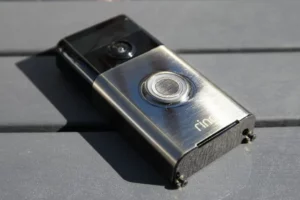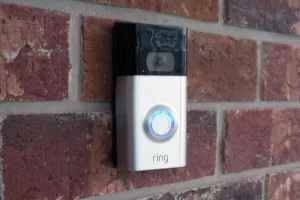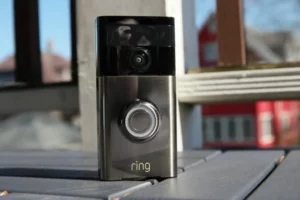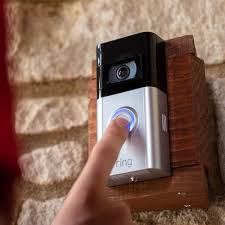Have you been capturing eerie orbs in your Ring camera photos and videos? These mysterious balls of light might seem like ghosts, but in reality, they are most likely just a simple trick of the light!
Ring cameras often catch these orbs due to a photography effect known as backscattering. This phenomenon occurs when small objects, such as dust particles or tiny insects, scatter light in low-light conditions. Fear not, though, as there are ways to reduce the number of orbs your Ring camera captures.
To mitigate the appearance of orbs, you can take some measures. Improve your lighting setup to minimize the effect of backscattering. Lowering your camera’s motion sensitivity can also help, as it might be triggering the camera to capture more orbs than necessary. Additionally, consider turning on snooze mode in specific areas where you notice a higher occurrence of orbs.
Let’s embark on a little Ring ghost-busting adventure and uncover the true cause behind these peculiar orbs!
Which Ring Devices Can Record Orbs?
It might come as a surprise, but every single Ring device equipped with a camera has the potential to record orbs and other peculiar visual phenomena. Whether it’s a Ring Doorbell (ranging from the 1-4 battery models to the Wired, Pro 1, and Pro 2), an Indoor Cam, Stick Up Cam, Floodlight Cam, or Spotlight Cam, they all have the capability to capture these mysterious orbs at some point during their operation.

At first glance, one might be inclined to think that this is a flaw in Ring’s camera design. With every camera capable of picking up orbs, it may seem like there’s an issue with their chosen design. However, the truth lies in the science of how cameras work.
The appearance of orbs and similar visual oddities is not unique to Ring cameras; it’s a phenomenon that can occur with any camera. This occurrence is rooted in the fundamental principles of camera optics and how they interact with the environment. Often, these phenomena are the result of backscattering, as mentioned earlier, caused by small objects scattering light in low-light conditions.
So, it’s not a flaw specific to Ring’s design, but rather a common characteristic of cameras in general. Understanding this science helps us demystify the presence of orbs and other visual anomalies that may be captured by Ring cameras and other similar devices.
How Does Ring Camera Record?
To discuss orbs, we must first understand the visual phenomenon known as backscattering.
Some individuals claim that the orbs they capture in their photographs or videos are ghosts or spiritual entities, but we can dismiss certain orbs as mere examples of photographic backscattering. Backscattering occurs when particles, such as dust or rain, that are out of focus scatter light while being extremely close to the camera lens.
This phenomenon can affect your Ring camera just as easily as it can impact an expensive professional photography camera. Backscattering is governed by the fundamental physics of how light interacts with the technology used to capture images. However, there are other considerations specific to Ring cameras that we need to take into account.
Certain Ring doorbells and cameras record at only 15 frames per second, which is much lower than the standard 24 frames per second used in Hollywood movies and considerably lower than the capabilities of modern smartphones.
Despite the lower frame rate, recording at 15 frames per second has its advantages. It reduces file sizes, making it easier to transmit footage to your devices and consuming less overall bandwidth. Furthermore, it still captures valuable information, whether it’s identifying visitors or potential intruders.
However, the trade-off for using 15 frames per second is a slight loss of performance when it comes to capturing fast-moving small objects. Insects and small birds can move at speeds that fall in between the frames recorded by your Ring camera.
While a smartphone might be able to capture a clear image of a fast-flying insect, a Ring camera may only capture a blurry image for a single frame. This is especially true for tiny insects that can also contribute to backscattering.
Many of the strange videos circulating online from Ring doorbell cameras are likely insects or birds moving too quickly for the camera’s frame rate, resulting in peculiar visual effects that can be mistaken for mysterious entities or even UFOs.
Additionally, Ring cameras often feature night vision, which introduces its own unique challenges when it comes to capturing orbs and other phenomena in low-light conditions.
How Does Ring Night Vision Works?
Night vision can indeed create an eerie effect, but the clarity it provides in the darkness is impressive.

The darkness of the night is not as absolute as it appears to our eyes, particularly when viewed through a night vision camera. Light consists of various wavelengths, but only a small range falls within the visible spectrum for humans. There are many wavelengths of light that our naked eyes cannot perceive.
Night vision cameras capitalize on this fact. Ring cameras, for instance, use infrared wavelengths of light to illuminate the environment and facilitate their recordings. Even though it may seem pitch dark outside, your front yard is actually illuminated with powerful infrared lights from your Ring technology, allowing clear recording during the night.
However, this use of infrared light is also what can cause backscattering, similar to what occurs with visible daylight. The infrared light can interact with particles like dust, leading to the appearance of orbs and other visual anomalies.
In addition to traditional black-and-white night vision, some Ring devices offer a feature called “Color Night Vision,” which uses available color information in an image to add color to a night-vision scene. This option can be useful for identifying people or objects in the frame, but it’s not flawless. Sometimes, when toggling the false color setting on, the Ring camera may not accurately apply colors, leading to visual artifacts that make things appear as if they are floating or moving, even when they are not. Essentially, Ring falsely applies color to dust and other small objects that would otherwise go unnoticed.
So, while night vision technology provides valuable visibility in the dark, it can also produce interesting visual effects, and understanding how it works helps us interpret the images and videos captured by Ring cameras during nighttime.
What Exactly Are Orbs?
While we cannot completely dismiss the possibility of ghosts, there are several known phenomena that can cause cameras to record orbs. Orbs are typically a result of how cameras record images and what gets captured in the frame.
One likely cause of orbs is simple dust. Dust particles, whether outside or indoors, are highly prone to backscattering, which creates the orb effect. These particles can float in the air, capturing and reflecting light in a way that produces orbs. You can even conduct a test yourself by taking a digital camera and photographing in a dusty room with dim lighting and using a flash.

Water droplets are another common culprit. Even when it’s not raining, water droplets can hang in the air and lead to the appearance of orbs in your Ring camera recordings. People often overlook this cause, as they may not consider that water droplets could be present in the atmosphere, perhaps from a neighbor gardening or other activities.
Common household insects can also contribute to orb sightings. Small insects tend to gather around bright light sources, including infrared light used in night vision mode. Some of these insects may even make their way indoors, leading to backscattering and orb-like effects in your indoor Ring recordings.
Lastly, the lighting itself plays a crucial role. Backscattering, which causes orbs, predominantly occurs in low-light settings. Bright, focused lighting, such as using a flash or the infrared light in night vision mode, inadvertently creates an ideal setup for backscattering and orb photography.
While capturing a few orbs occasionally can add excitement and mystery to your Ring recordings, dealing with them as a long-term problem requires some solutions.
If orbs become bothersome in your recordings, you can try the following:
- Improve lighting: Enhance the overall lighting in the areas where you frequently notice orbs. This can reduce the occurrence of backscattering.
- Adjust motion sensitivity: Lower the motion sensitivity of your Ring camera to prevent it from capturing insignificant movements that may trigger false orb-like effects.
- Night vision adjustments: If your Ring camera has a false color option (Color Night Vision), consider toggling it off if it produces unwanted visual artifacts.
- Keep the lens clean: Regularly clean the camera lens to minimize the impact of dust particles on the recorded images.
By implementing these measures, you can reduce the appearance of orbs in your Ring camera footage and focus on capturing more accurate and clear recordings.
How To Stop Ring Cameras From Recording Orbs?
To minimize orbs in your Ring recordings, here are the four best methods, though it’s essential to remember that completely eliminating orbs may not be possible due to the nature of photography and backscattering.

- Lower Motion Sensitivity: By reducing the motion sensitivity on your Ring device, you can prevent it from recording every little movement, such as insects or dust particles, that might trigger false orb-like effects. Here’s how to adjust motion sensitivity on your Ring camera:
- Open the Ring app.
- Tap the three lines to access the Ring menu.
- Select “Devices.”
- Choose the Ring camera that has been capturing orbs.
- Tap “Motion Setting.”
- Select “Motion Sensitivity.”
- Adjust and lower the Motion Sensitivity Slider.
- Tap “Save” in the upper right corner.
Experiment with different sensitivity settings to find the right balance between capturing essential recordings and avoiding unnecessary orb photography.
- Change Your Lighting: Backscattering, which causes orbs, often occurs in low-light settings with a single high-powered light source. To reduce this effect, add a second source of light to brighten up the image and minimize scattering. Consider installing a second infrared light near your Ring camera and aligning it in a way that its beam intersects with the infrared light from your Ring camera. Avoid stacking the lights directly on top of each other to prevent exacerbating the orb issue.
- Snooze Mode: If you are dealing with a particularly dusty environment or experiencing a rainstorm, using the Snooze Mode can be helpful. This feature turns off notifications from your Ring camera for a set duration, reducing the number of recordings capturing orbs.
To enable Snooze Mode for your Ring camera:
- Open the Ring app.
- Tap the three lines menu.
- Select “Devices.”
- Locate your Ring camera.
- Tap “Motion Snooze.”
- Move the Motion Snooze slider to set the duration.
- Tap the “Save Snooze Settings” button.
If you want to turn off Snooze Mode, you can easily do so by returning to the Motion Snooze menu and disabling the feature.
While these methods can significantly reduce the appearance of orbs in your Ring recordings, remember that occasional orbs may still appear due to the inherent characteristics of photography and the physics of backscattering.

You May Also Enjoy Reading: Ring Video Doorbell Flashing White Light! How to Fix It?

